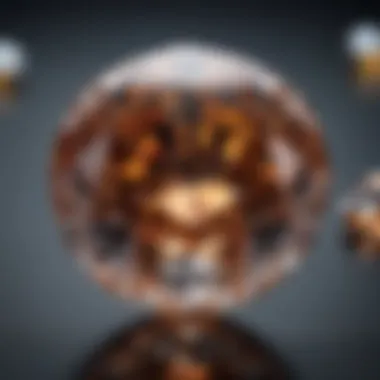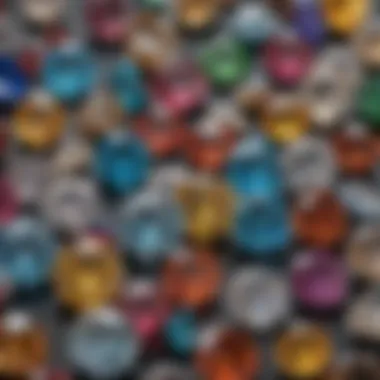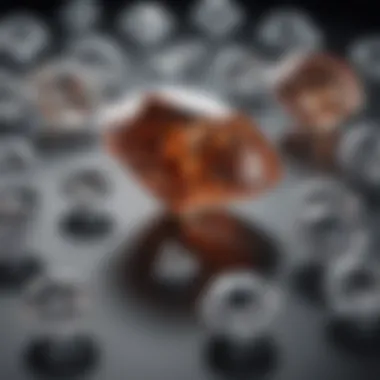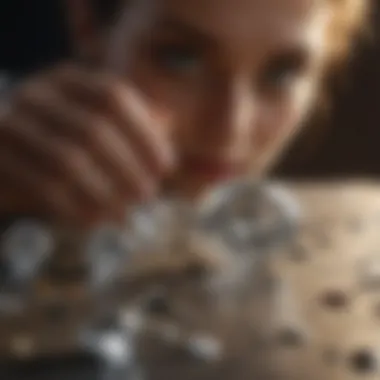Understanding the Value of Seven Carats of Diamonds


Intro
Understanding the value of diamonds, especially those weighing seven carats, requires a nuanced approach that considers various factors. Each diamond is unique, and its worth is determined not just by its size but by its overall quality, market demand, and cultural significance. This article provides a comprehensive analysis of what contributes to the value of seven carats of diamonds, making it essential for gemstone enthusiasts, collectors, and jewelry designers.
Gemstone Overview
Definition and Characteristics
Diamonds are crystalline forms of carbon known for their remarkable hardness and brilliance. Their structure allows them to reflect light in a way that creates exquisite sparkle. The intrinsic beauty of diamonds, combined with their durability, makes them highly sought after as gemstones.
Classification of Gemstones
Gemstones are categorized based on their physical and chemical properties. Diamonds fall under precious gemstones, distinguished by their rarity and high market value. Other categories include semi-precious stones and organic gemstones, which differ significantly in composition and worth. For diamonds, the four Cs—Carat, Clarity, Color, and Cut—serve as benchmarks for distinguishing quality.
Properties of Gemstones
Physical Properties
Diamonds possess extraordinary physical properties. Their hardness is rated as 10 on the Mohs scale, making them resistant to scratching. Transparency varies among diamonds, influencing the amount of light that can pass through.
Chemical Properties
The chemical composition of diamonds primarily consists of carbon atoms. The arrangement of these atoms contributes to their unique characteristics. Diamonds can also contain trace elements which may alter their color, leading to variations in value.
"The value of a diamond is often a reflection of its origin, clarity, and overall market demand."
Factors Influencing Value
Considering the value of seven carats of diamonds, one must explore several influencing elements including:
- Carat Weight: The weight of the diamond impacts its price significantly—larger diamonds often fetch higher prices per carat.
- Clarity: Refers to the presence of inclusions or blemishes. Higher clarity stones yield better values.
- Color: Although most diamonds are colorless, others may have tints that affect their desirability and worth.
- Cut: The way a diamond is cut directly influences its sparkle and overall appearance, which in turn affects its valuation.
While studying seven carat diamonds, it is important to understand how these elements intersect to create a more profound valuation. The dynamics between the factors also reveal much about market trends, buyer preferences, and the ethical implications surrounding diamond sourcing.
By exploring these core components, readers can gain deeper insights into the valuation process, recognizing that the worth of diamonds goes beyond their physical attributes.
Prolusion to Diamond Valuation
Understanding how diamonds are valued is essential for anyone interested in purchasing or investing in these precious stones, particularly when it comes to larger weights like seven carats. This article aims to shed light on various aspects that contribute to the overall worth of diamonds. By dissecting carat weight, clarity, color, and cut — commonly known as the Four Cs — readers can gain a clearer perspective on what to consider.
The complexities surrounding diamond valuation are significant. An informed buyer can better appreciate the nuances of diamond quality and pricing. This leads to more satisfying purchases and can greatly influence the investment's long-term value.
Assessing the value of seven carats of diamonds involves more than just looking at carat weight. The market's trends, the role of retailers, and ethical sourcing add layers to the evaluation. Understanding these dimensions will enable potential buyers or collectors to navigate the diamond market effectively.
Understanding Carat Weight
Carat weight serves as a primary determinant in the diamond's value. One carat equals 200 milligrams, and diamonds are generally priced higher as their carat weight increases. However, weight alone does not dictate value; it is just one of the four essential elements in valuation.
When evaluating a seven-carat diamond, buyers must recognize that while its size is impressive, other factors like clarity and cut can dramatically influence its price. Importantly, weight must be understood in context with these other characteristics to provide a well-rounded view of value.


Overview of the Four Cs
The Four Cs concept is the foundation of diamond valuation, and each C plays a critical role in determining the stone's worth.
Carat
Carat weight is the most visible characteristic among the Four Cs. For seven-carat diamonds, it indicates a significant size that catches attention. Larger diamonds are rarer; thus, their prices can soar dramatically. However, while carat can attract immediate interest, it is important to keep in mind the overall quality.
A lesser carat weight with superior clarity and cut can have a comparable value due to its beauty and rarity. Buyers should focus on how carat weight aligns with these other attributes for an insightful valuation.
Clarity
Clarity indicates the presence of internal or external imperfections, known as inclusions and blemishes. A diamond with high clarity will have fewer visible flaws, increasing its value. For seven-carat stones, clarity becomes even more essential as any visible inclusion is magnified due to the diamond's size.
High-clarity diamonds are highly sought after and can command high prices. Buyers must assess clarity carefully, as even slight imperfections can affect brilliance and desirability.
Color
Color grading refers to the absence of color in diamonds, with a preference for those that are completely colorless. The diamond’s hue can greatly influence its value. In the case of seven-carat diamonds, any tinge can be more noticeable and its grading can significantly impact pricing.
As lighter shades such as D to F offer high value, inclusions can lower appreciation in comparison to diamonds with rich color saturation that draw buyers' attention for diverse reasons.
Cut
Cut quality is unique as it not only affects the diamond's appearance but also its brilliance. The precision of the cut can determine how well a diamond reflects light. A well-cut seven-carat diamond will showcase brilliance and fire, enhancing its visual appeal.
Conversely, a poorly cut diamond, even if larger, will look lifeless and dull. The cut can either elevate the overall desirability or diminish it, making it a critical consideration in evaluating the worth of any stone.
Market Value of Diamonds
Understanding the market value of diamonds is crucial when assessing the worth of seven carats. This topic encompasses various factors that influence the pricing of diamonds, including supply and demand dynamics, consumer preferences, and the overall economic environment. The fluctuating market trends can significantly impact the valuation. Additionally, assessing the role of retailers and wholesalers helps in understanding how the pricing strategies work and how prices can vary. By exploring these aspects in depth, readers will gain a comprehensive grasp of what affects the market value of diamonds, particularly those weighing seven carats.
Current Market Trends
Recent market trends indicate a marked interest in larger diamonds, such as those weighing seven carats. Buyers are increasingly favoring stones that offer a good balance between carat weight, clarity, and cut. The shift towards sustainable and ethically sourced jewels also influences the buying choices significantly.
Factors such as economic conditions and consumer confidence play pivotal roles in trend direction. For instance, when the economy is doing well, buyers may invest more in luxury items, thus driving demand. Conversely, during economic downturns, spending tends to decline, impacting the overall market. Analytical data shows a steady rise in the value of high-quality stones.
Role of Retailers and Wholesalers
Retailers and wholesalers are essential players in the diamond market. They connect suppliers to consumers and influence pricing. The strategies they adopt significantly affect how diamonds are valued in the market. Retailers often mark up prices to cover overhead costs and profit margins, which can lead to variations in pricing across different shops.
Wholesalers typically sell diamonds to retailers at a lower price, as they operate on bulk sales. This can offer retailers more flexibility in setting their prices. However, not all retailers follow the same pricing model, which can create disparities in market value.
"The relationship between retailers and wholesalers is crucial for understanding how diamond pricing evolves."
By navigating the complexities between these two groups, buyers can often find better deals. Being aware of the current market trends and the roles of different players can empower consumers, helping them make more informed decisions.
Defining Factors Influencing Diamond Prices
Understanding the factors that influence diamond prices is essential for anyone in the market for such an investment. Multiple elements affect how a diamond's worth is determined. Recognizing these will help potential buyers and sellers make informed decisions.


Effects of Clarity on Value
Clarity refers to the presence of flaws, known as inclusions and blemishes, within a diamond. Higher clarity ratings, indicating fewer imperfections, typically translate into higher market values. For example, a diamond graded as "Flawless" is significantly rarer than one graded as "Included". The rarity of a high-clarity stone contributes to its desirability and price.
Buyers often prefer diamonds with a clarity of VS1 (Very Slightly Included) or higher, which ensures minimal visible inclusions to the naked eye. It is also appreciable to note that each grade plays a crucial role in price determination. Generally, as clarity improves, the price per carat increases exponentially, creating a marked difference in total value for stones of the same carat weight but differing in clarity.
Color Grading and Its Impact
The color of a diamond directly influences its value, with a spectrum ranging from completely colorless (D) to light yellow (Z). Colorless diamonds are the most highly valued because of their rarity. Supposedly, the less color in a diamond, the higher its worth.
When considering a diamond's color, buyers should focus not only on the grade but also on the effect of color within the specific lighting conditions where the diamond will be displayed. Different diamond types, like fancy colored diamonds, defy this conventional rule. Their value is determined more by hue, tone, and saturation than by the lack of color, complicating straight comparisons.
Cut Quality as a Price Determinant
The cut quality of a diamond arguably affects its beauty and overall brilliance. This attribute refers to how well a diamond has been cut and shaped from its raw form. It assesses the angles, proportions, and finish of the diamond. A well-cut diamond reflects light better, yielding a more brilliant appearance, which significantly boosts its market value.
Cuts are rated on a scale from Excellent to Poor, with higher-rated cuts showing more sparkle and life. A diamond can have a high carat weight but low value if its cut is substandard. Thus, cut quality is a crucial aspect in the diamond selection process and should not be overlooked.
"A cut of high quality can elevate a diamond's value, aligning it closer to its potential worth."
Awareness of these defining factors can empower buyers, enabling them to navigate the complexities of the diamond market more adeptly. Each attribute must be weighed when determining a diamond's price, particularly for notable stones such as seven carats.
Calculating the Value of Seven Carats
Calculating the value of seven carats is crucial within the overall context of diamond evaluation. This section aims to break down the various elements that contribute to the determination of worth in diamonds, particularly focusing on the significant benchmark of seven carats. This weight often represents a luxurious point in diamond valuation, as stones of this size are not only rare but also carry a unique status. The process involves different methods and factors, which may differ extensively from other weights. Here, we will delve into the methods of estimating price per carat and calculating the total value, shedding light on what diamond enthusiasts should consider during their purchase or evaluation.
Estimating Price per Carat
Estimating the price per carat is one of the foundational steps in understanding the overall worth of a diamond. This segment emphasizes the importance of identifying current market rates, as these values fluctuate based on various elements, including overall demand, market trends, and the rarity of larger stones. Generally, larger carat sizes, particularly at the seven-carat mark, command premium prices as they are less common than smaller stones.
When determining price per carat, one must consider the quality of the diamond under the Four Cs: clarity, color, cut, and carat itself. Higher-quality diamonds will usually have a more substantial price per carat than lower-quality diamonds. Remember to factor in the following:
- Quality of the diamond: Always assess the clarity, cut, and color alongside carat weight.
- Market conditions: Stay updated on current trends and fluctuations in diamond pricing.
- Retailer versus wholesaler prices: Understand the difference in pricing between retail stores and wholesale dealers.
"The price per carat for larger diamonds exponentially rises due to their rarity, making it pivotal to grasp how these dynamics work."
Calculating Total Value
Calculating the total value of a seven-carat diamond is an extension of estimating the price per carat. This calculation takes the price per carat determined in the previous step and applies it to the total carat weight. For example, if the price per carat is set at a certain dollar amount, you can easily compute the total value by multiplying that number by seven. However, several other factors can lead to adjustments in this straightforward calculation.
One factor to consider is the provenance and sourcing of the diamond. Ethical sourcing may influence value, as ethically-sourced diamonds often have a higher market demand and thus can fetch premium pricing. Additionally, special features of the diamond, such as unique color saturation or historical significance, may also add to its total value.
The formula can be summarized as follows:
Buyers must also consider other expenses such as certification costs and any additional premiums for unique attributes. Therefore, understanding how to calculate the total value of a diamond provides a comprehensive outlook on the financial commitment involved in purchasing a seven-carat diamond.
Comparative Valuation
In the study of diamonds, understanding comparative valuation is crucial for grasping how different characteristics influence worth. This section sheds light on how seven carats measure up against other carat weights and offers insights into historical pricing trends. When considering the value of a diamond, especially one weighing seven carats, various parameters come into play that often dictates demand and pricing.


Seven Carats vs. Other Carat Weights
Seven carats of diamonds represent a significant weight that often denotes rarity and desirability. When compared to smaller carat weights, the price does not rise linearly. Instead, the increase in value can multiply exponentially with the rise in carat weight.
- Perceived Value: Gems above certain thresholds, like five or seven carats, often command higher prices than multiple smaller stones of equal total carat weight. This is due to market perception and desirability for larger stones.
- Market Scarcity: Seven-carat diamonds are rare. Finding gems of this weight with excellent clarity and color becomes increasingly difficult. Such scarcity raises prices in the marketplace, highlighting a law of supply and demand.
- Quality Considerations: Larger diamonds need to excel across the Four Cs—cut, clarity, color, and carat. A seven-carat stone must outperform smaller diamonds in at least one or two areas to justify a significantly higher price. Large stones of lower quality may not attract buyers unless priced accordingly.
"The worth of a diamond isn't solely a product of carat weight, but how it harmonizes with other quality factors that define its uniqueness and beauty."
In summary, comparative valuation helps practitioners, collectors, and enthusiasts to understand that price discrepancies are not random but rather reflect underlying characteristics and market dynamics.
Historical Context of Diamond Pricing
The historical context of diamond pricing provides essential insights into how market forces have shaped values over time. The value of diamonds has evolved alongside economic, cultural, and technological changes.
- Economic Factors: The economic boom periods have often driven demand for luxury goods, including diamonds. Notable events, like the post-World War II economic expansion, led to an increased middle-class affluence, thus dominating diamond purchasing behaviors.
- Cultural Significance: Over the decades, diamonds have been imbued with cultural significance. Their association with wealth and status influences how they are perceived and valued. Understanding cultural shifts helps contextualize current market trends.
- Technological Advancements: Innovation in mining techniques, synthetic diamond production, and cutting technologies have also impacted pricing. The discovery of large deposits shifted supply and consequently influenced market dynamics.
Ethics and Source of Diamonds
The significance of ethics in the diamond industry has gained increased attention in recent years. It is crucial to understand the ethical implications surrounding diamond sourcing as it plays a vital role in consumer decisions, market trends, and ultimately, the value of diamonds, especially those weighing seven carats. Ethical sourcing encompasses the practice of acquiring diamonds that are mined, traded, and sold in compliance with ethical standards, which ensures labor rights, environmental preservation, and community welfare.
Understanding Ethical Sourcing
Ethical sourcing refers to the process of collecting diamonds from mines that adhere to ethical practices. This includes respecting human rights, providing fair labor conditions, and engaging in environmentally sustainable operations. Furthermore, the Kimberly Process Certification Scheme aims to prevent the trade of conflict diamonds that are used to finance armed insurgencies.
Consumers increasingly demand transparency about the origins of their diamonds. As awareness about unethical practices spreads, the demand for ethically sourced diamonds has risen. This shift requires gemstone enthusiasts, collectors, and jewelry designers to prioritize sources that demonstrate integrity in their practices.
Several factors contribute to ethical sourcing:
- Transparency: Knowing where and how diamonds are sourced creates trust between consumers and retailers.
- Fair Trade: Support local communities and promote fair wages for miners.
- Environmental Responsibility: Adoption of practices that minimize the ecological impacts of mining.
By choosing ethically sourced diamonds, buyers not only align their values with their purchases but also contribute to a more responsible industry.
Impact on Market Value
The market value of diamonds can be significantly affected by their ethical sourcing. Consumers today are willing to pay a premium for diamonds that come with a guarantee of ethical practices. This phenomenon reflects a growing trend in consumer behavior, where buyers prioritize ethics alongside traditional factors such as carat, clarity, color, and cut.
Some effects of ethical sourcing on market value include:
- Increased Demand: Ethical diamonds are often in greater demand, leading to potential increases in their market prices.
- Brand Value: Companies seen as socially responsible often enjoy enhanced brand loyalty and reputation.
- Resale Value: Ethical provenance can positively influence the resale price of diamonds in the secondary market.
Concluding Thoughts
Evaluating the worth of diamonds is a nuanced process that merges elements of science, market dynamics, and personal desire. In this article, we have examined various facets that contribute to the valuation of seven carats of diamonds. This section synthesizes insights from previous discussions and emphasizes why understanding these elements is crucial for anyone engaging with the diamond market.
Future of Diamond Valuation
As we look ahead, the valuation of diamonds, particularly those weighing seven carats or more, is likely to undergo significant transformations. The increasing demand for ethically sourced gems influences buyers' behaviors today.
New technologies in both grading and authentication are emerging, providing enhanced accuracy in assessing clarity and cut. These technological advancements could refine how diamonds are priced, leading to a more transparent market. Blockchain technology, for instance, can trace the provenance of diamonds, ensuring ethical sourcing and potentially increasing their value.
Market trends also point to a growing preference among consumers for sustainable luxury items. This shift might see prices fluctuate as demand for ethically mined diamonds continues to rise.
Final Insights on Seven Carats
Seven carats holds a special place in the world of diamonds. It often signifies not just the beauty of the stone but also a substantial financial commitment. This size can evoke emotions tied to milestones, cultural significance, and personal status.
The value of a seven-carat diamond is influenced by all the previously discussed factors—carat, clarity, color, and cut. As these elements interact, they create a unique narrative for each stone that goes beyond mere monetary value.



